 W
WAn angle plate is a work holding device used as a fixture in metalworking.
 W
WA caliper is a device used to measure the dimensions of an object.
 W
WA combination square is a multi-purpose measuring and marking tool used in metalworking, woodworking, and stonemasonry. It is composed of a rule and one or more interchangeable heads that can be attached to the rule.
 W
WA coordinate measuring machine (CMM) is a device that measures the geometry of physical objects by sensing discrete points on the surface of the object with a probe. Various types of probes are used in CMMs, including mechanical, optical, laser, and white light. Depending on the machine, the probe position may be manually controlled by an operator or it may be computer controlled. CMMs typically specify a probe's position in terms of its displacement from a reference position in a three-dimensional Cartesian coordinate system. In addition to moving the probe along the X, Y, and Z axes, many machines also allow the probe angle to be controlled to allow measurement of surfaces that would otherwise be unreachable.
 W
WCylindrical coordinate measuring machine or CCMM, is a special variation of a standard coordinate measuring machine (CMM) which incorporates a moving table to rotate the part relative to the probe. The probe moves perpendicular to the part axis and radial data is collected at regular angular intervals.
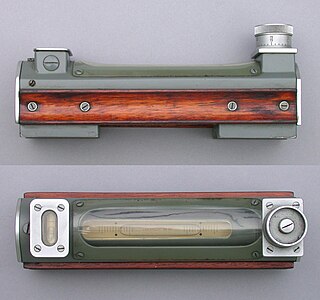 W
WAn engineer's spirit level is generally used to level machines, although they may also be used to level large workpieces on machines such as planers. Using gravity as a reference and checking a machine's axis of travel at several points, the level is used to ensure the machine's axis is straight. A perfectly level machine does not actually need to be achieved, unless the particular manufacturing process requires it. Spirit levels are also used in building construction by carpenters and masons.
 W
WA feeler gauge is a tool used to measure gap widths. Feeler gauges are mostly used in engineering to measure the clearance between two parts.
 W
WGauge blocks are a system for producing precision lengths. The individual gauge block is a metal or ceramic block that has been precision ground and lapped to a specific thickness. Gauge blocks come in sets of blocks with a range of standard lengths. In use, the blocks are stacked to make up a desired length.
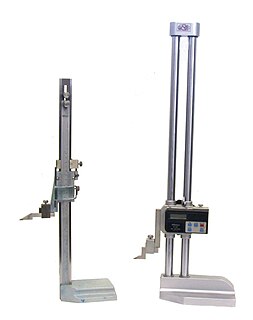 W
WA height gauge is a measuring device used for determining the height of objects, and for marking of items to be worked on.
 W
WIn various contexts of science, technology, and manufacturing, an indicator is any of various instruments used to accurately measure small distances and angles, and amplify them to make them more obvious. The name comes from the concept of indicating to the user that which their naked eye cannot discern; such as the presence, or exact quantity, of some small distance.
 W
WA machinist square or engineer's square is the metalworkers' equivalent of a try square. It consists of a steel blade inserted and either welded or pinned into a heavier body at an angle of 90°. Usually a small notch is present at the inside corner of the square. This prevents small particles from accumulating at the juncture and affecting the square's reading.
 W
WMarking blue, layout stain or Prussian blue is a dye used in metalworking to aid in marking out rough parts for further machining. It is sometimes called Dykem. It is used to stain or paint a metal object with a very thin layer of dye that can be scratched off using a scriber or other sharp instrument to reveal a bright, yet very narrow line in the metal underneath. The advantages are that any existing scratches are covered with the dye and the new lines have a contrasting background.
 W
WA marking gauge, also known as a scratch gauge, is used in woodworking and metalworking to mark out lines for cutting or other operations. The purpose of the gauge is to scribe a line parallel to a reference edge or surface. It is used in joinery and sheetmetal operations.
 W
WAn optical comparator or profile projector is a device that applies the principles of optics to the inspection of manufactured parts. In a comparator, the magnified silhouette of a part is projected upon the screen, and the dimensions and geometry of the part are measured against prescribed limits. It is a useful item in a small parts machine shop or production line for the quality control inspection team.
 W
WA profilometer is a measuring instrument used to measure a surface's profile, in order to quantify its roughness. Critical dimensions as step, curvature, flatness are computed from the surface topography.
 W
WA radius gauge, also known as a fillet gauge, is a tool used to measure the radius of an object.
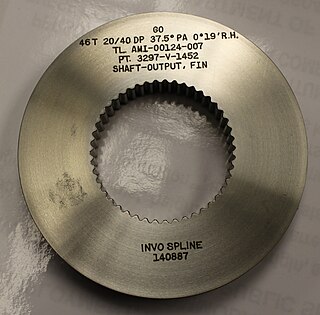 W
WA ring gauge, or ring gage, is a cylindrical ring of a thermally stable material, often steel, whose inside diameter is finished to gauge tolerance and is used for checking the external diameter of a cylindrical object.
 W
WA ruler, sometimes called a rule or line gauge, is a device used in geometry and technical drawing, as well as the engineering and construction industries, to measure distances or draw straight lines.
 W
WA sine bar consists of a hardened, precision ground body with two precision ground cylinders fixed at the ends. The distance between the centers of the cylinders is precisely controlled, and the top of the bar is parallel to a line through the centers of the two rollers. The dimension between the two rollers is chosen to be a whole number and forms the hypotenuse of a triangle when in use.
 W
WA snap gauge is a form of go/no go gauge. It is a limit gauge with permanently or temporarily fixed measurement aperture(s) (gaps) which is used to quickly verify whether an outside dimension of a part matches a preset dimension or falls within predefined tolerances.
 W
WA square is a tool used for marking and referencing a 90° angle, though mitre squares are used for 45° angles. Squares see common use in woodworking, metalworking, construction and technical drawing. Some squares incorporate a scale for measuring distances or for calculating angles.
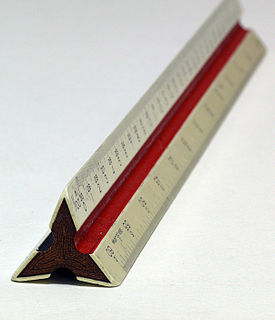 W
WA straightedge or straight edge is a tool used for drawing straight lines, or checking their straightness. If it has equally spaced markings along its length, it is usually called a ruler.
 W
WA surface plate is a solid, flat plate used as the main horizontal reference plane for precision inspection, marking out (layout), and tooling setup. The surface plate is often used as the baseline for all measurements to a workpiece, therefore one primary surface is finished extremely flat with tolerances below 11.5 μm or 0.0115 mm per 2960 mm for a grade 0 plate. Surface plates are a common tool in the manufacturing industry and are often fitted with mounting points so that it can be an integrated structural element of a machine such as a coordinate-measuring machine, precision optical assembly, or other high precision scientific & industrial machine. Plates are typically square or rectangular, although they may be cut to any shape.
 W
WA tape measure or measuring tape is a flexible ruler used to measure size or distance.
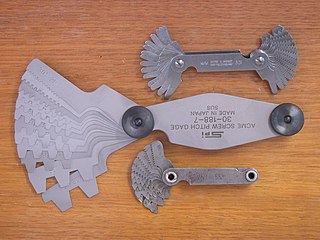 W
WA thread gauge, also known as a screw gauge or pitch gauge, is used to measure the pitch or lead of a screw thread.
 W
WA wiggler, also known as a wobbler, edge-finder, center-finder or laser-centering-device, is a tool used with a machine like a mill, to accurately align the machine head with the work prior to machining.